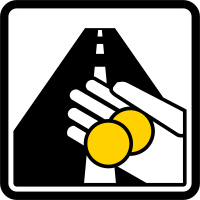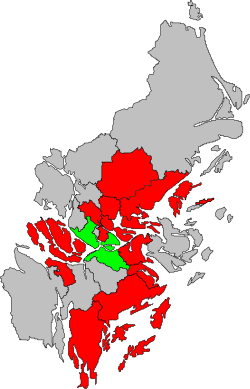Stockholm congestion tax
[1] The congestion tax was implemented on a permanent basis on 1 August 2007,[2][3] after a seven-month trial period between 3 January 2006 and 31 July 2006.
[4] It was inspired by Singapore's Electronic Road Pricing (ERP) system, which was first introduced as the Area Licensing Scheme in 1975.
On 1 October 2006, the leaders of the winning parties in the 2006 general election, declared they would implement the Stockholm congestion tax permanently.
[8] There are unmanned electronic control points (in Swedish: betalstation, literally payment station)[1] at all entrances to this area.
[7] One week after the tax began to be charged, traffic on the motorway had decreased by 22% compared to a normal day in mid-December.
The objective was to steer the traffic towards other times of the day and public transport, and in this way reduce congestion in the Inner City area.
[15] Failure to pay the tax within the allotted time results in a reminder bill being sent with an added 500 SEK fee.
Private individuals may deduct the congestion tax for business journeys, and for traveling between the home and workplace according to the usual rules of car cost deduction (1:80 SEK/km), that is if the distance is at least 5 kilometres (3.1 mi) and the time saved by traveling by own car compared to public transport is at least 2 hours per day.
The exemption was removed as a result of objections from companies relating to unfair taxation, and because the "Eurovignette" EU directive (1999/62/EC article 7 and 2006/38/EC) requires that user charges may not discriminate on the grounds of the nationality of the haulier or the origin of the vehicle.
The equipment, consisting of cameras, laser detectors, antennas, and information signs are mounted on a set of gantries at each control point.
The DSRC transponders that were used during the congestion tax trial period are useless now and should be returned to the Swedish Road Administration.
In the time since the control points were put in place, however, the debate has calmed down considerably as the system works smoothly and the actual cost of passing these stations is acceptable to most residents, as well as the fact that central Stockholm has been getting cleaner since the proposition went into action.
The debate has instead in many instances shifted toward the political reasons behind the proposition, where some argue that the proposition is simply a way to punish the residents of Stockholm for the centralized Swedish political system, which reportedly many people in rural parts of Sweden feel favours Stockholm above other regions.
In addition to the optical recognition of license plates, DSRC transponders were used to identify vehicles, and opting to use one was a precondition for using direct debit for the payment of the tax.
The Social Democratic government prior to the 2006 general election (cabinet Persson) stated that they would only take into consideration the results of the referendum held in Stockholm Municipality, while the opposition parties (Alliance for Sweden) stated that they would take into consideration the results of referendums the other municipalities as well if they won the election.
[citation needed] The opposition parties won the election and before they formed a government (cabinet Reinfeldt) their party leaders announced on 1 October 2006 to implement the congestion tax permanently, and that the revenue would go entirely to new road constructions in and around Stockholm instead of entirely to public transport in Stockholm as it was during the trial period.





